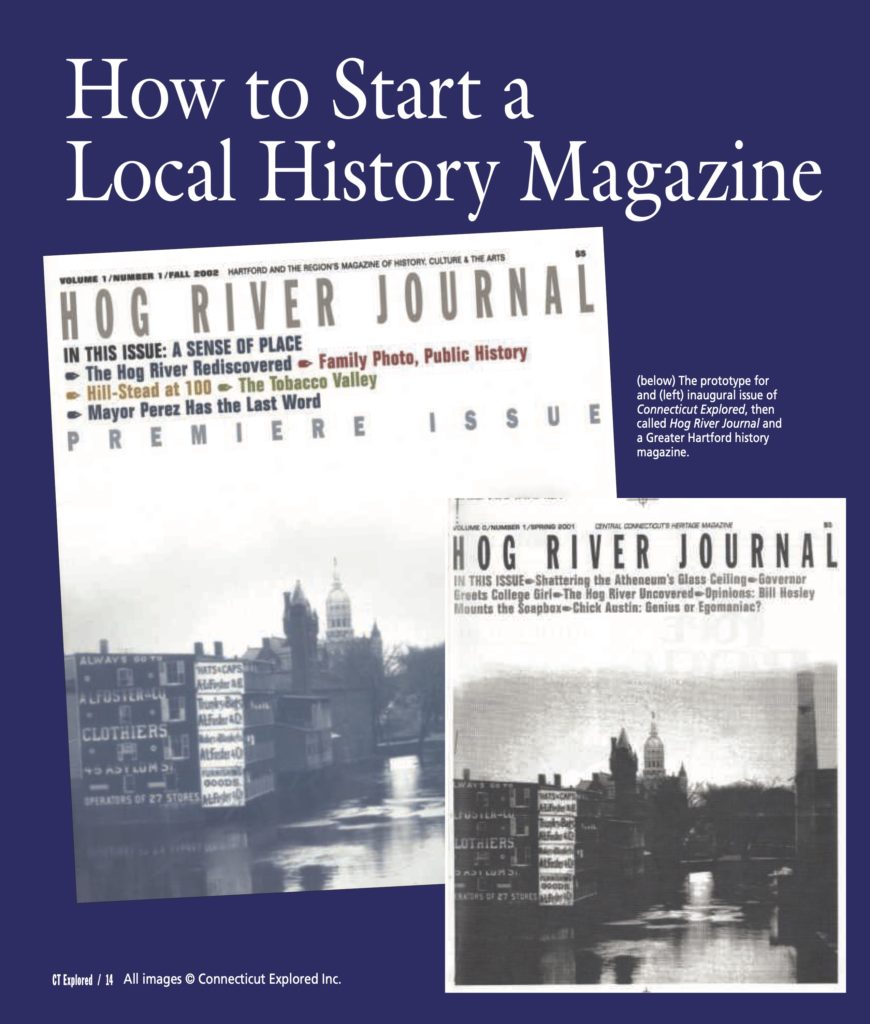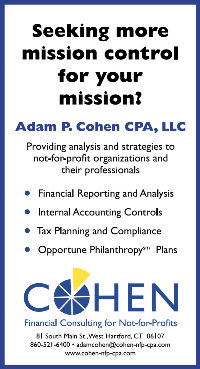(c) Connecticut Explored Inc. FALL 2022
Subscribe/Buy the Issue!
As I step down as founding publisher of Connecticut Explored after 20 years, the Board asked me to record the history of the magazine.
I cannot take credit for the idea. But I can take credit for recognizing a bold and exciting proposition, embracing it, and bringing it to fruition.
After a (short) career in insurance marketing, parlayed into a stint as the Wadsworth Atheneum’s membership coordinator and then interim director of Hill-Stead Museum, in 2000 I completed a Master’s degree in American Studies at Trinity College in Hartford. I took Susan Pennybacker’s course in Hartford history and was gobsmacked. I grew up in the Farmington Valley, yet I knew nothing about this history. I loved every class I took with Gene Leach, and he became my capstone paper advisor and, after the magazine’s launch, a vital editorial team member, contributing writer, and board member.
As I worked my way through the degree program, I was often asked, “So what are you going to do with that Master’s in American Studies?” It was a question I was asking myself. When my friend and former Wadsworth Atheneum colleague Cindy Cormier broached the idea of a magazine about local history, it fell on fertile ground.
Cormier, then curator at Hill-Stead Museum in Farmington, had come up with the idea with Claudia Thesing, who headed up Hill-Stead’s development office. The two lamented that while there was interesting work happening in the museum’s archives and collection, there were limited options for getting the word out. It’s hard now to remember a time when it wasn’t easy and inexpensive to throw up a website or launch an online publication. At the time, like most museums, Hill-Stead had a printed-and-mailed newsletter that was limited to program and fundraising news. Connecticut Historical Society and Connecticut Landmarks had published journals, long since axed by budget cuts. As for placing a story in the traditional media, efforts were generally futile.
What if, we mused, museums and historical societies joined forces? If no single organization could afford to publish a journal, could a group publish something together? In this respect CTExplored is an example of new media—it is created by and for a collective of people who love a certain topic. If the local paper didn’t care to cover our stories, we would publish them ourselves.
Cindy and I then called on our colleagues in museums and academia to see who might be interested in working on developing this as yet unnamed publication. And a fantastic group of people stepped forward (see the Honor Roll on page xx). For two years we met over dinner in each other’s homes to hash out the idea.
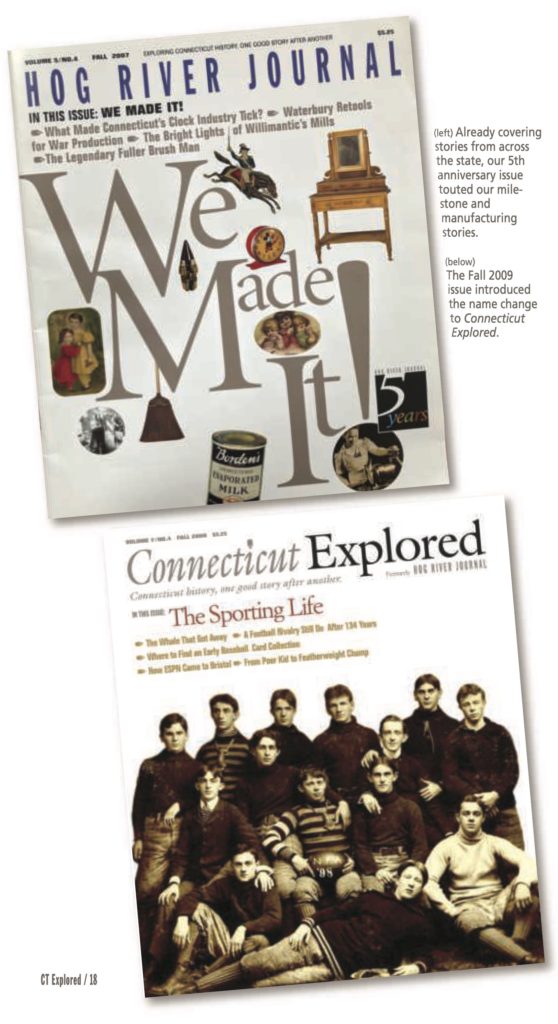
(top) Already covering stories from across the state, our 5th anniversary issue touted our mile- stone and manufacturing stories. (below) The Fall 2009 issue introduced the name change to Connecticut Explored.
From Big Idea to the First Issue
One thing we all agreed on was that we wanted to marry history with a very contemporary design aesthetic. This idea is so common now as to be unremarkable. But at the time, I worried that potential funders would be conjuring in their mind’s eye something dull and fusty, whereas we were imagining dynamic, glossy, and full color, with big historic images and lively, well-told stories. We needed a name and a prototype to convey what we had in mind.
We wanted a name that would catch people’s attention. We brainstormed and considered names like Harriet (a riff on John F. Kennedy Jr.’s George magazine, published from 1995 to 2001), or simply H (until someone suggested that was slang for heroin). We started out as a Greater Hartford history magazine, so we adopted the name Hog River Journal, changed—to many subscribers’ chagrin—to Connecticut Explored in Fall 2009, four years after we went statewide. Hog River was the nickname for the storied stream, prone to flooding, that had been buried under Hartford in the 1940s. For me, Hog River Journal was edgy and memorable, but it had its downsides. It didn’t resonate with anyone outside the Greater Hartford area, and the word “hog” was not appealing to many people. Even so, 20 years later, I still get comments from longtime and loyal subscribers who have never forgiven us for changing the name!
Next we needed a prototype. We solicited a few sample stories and turned to graphic designer John Alves, who has designed every issue since. He took his own approach to marrying the past and present. Alves recalled, “I researched publications from the Smithsonian, the National Geographic Society, and as far back as Life magazine, which I felt achieved a balance of photography and text that would engage readers. It was perfect timing with tech developments 20 years ago. A magazine could be produced much more simply than even 10 years before.”
How Do You Know?
With a name and a prototype in hand, I started to pitch the idea to potential funders. Invariably the first question I’d get was, “How do you know there’s a market for a magazine of local history?” “After all,” the person would continue, “if there was a market for it, it would already exist.” Indeed, in other states, such a magazine is generally published by the state historical society or state humanities council. But in Connecticut at the time, the leaders of those organizations had other interests and priorities. In fact, when I pitched the idea to then-longtime CTHumanities director Bruce Fraser, he flatly told me he didn’t support the idea. (After we launched, though, he graciously admitted he was wrong and, by the third issue, CT Humanities was on board as an organizational partner. Fraser’s next two successors fully embraced us and, for a time, CT Humanities was our co-publisher.)
The next question I’d get was, “Have you done your market research?” And there our merry band of dreamers reached a fork in the road. We could either spend $25,000 on a thorough market research study, or we could publish an issue and see what happened. For me, it simply came down to this: at the end of the day, what would I rather have to show for my efforts? A really good market research report or an actual issue of the magazine? We did some research with “key influencers” with the help of Beth Pite, but ultimately decided to launch and see what happened.
Meanwhile, there were other tasks to attend to. Should we start a new nonprofit organization? I was hesitant until we knew we had something viable. Fortunately we found a willing collaborator in Louise Blalock, chief librarian of Hartford Public Library. Blalock took us under her wing, and the library provided oversight as our fiscal agent. This arrangement lasted until we spun off as our own 501(c)(3) a decade later, in 2012.
With a plan, a prototype, and a great group of collaborators, I convinced enough generous folks to fund the launch of Hog River Journal in Fall 2002. I am eternally grateful to the late Millard Pryor and his wife Claire Pryor, giants in Greater Hartford arts philanthropy, and Chris Larsen, who, as publisher since 1967 of the local Imprint newspapers (its flagship West Hartford News founded in 1931 grew to include 14 weeklies under Chris’s leadership), knew a thing or two about the business. As a recent Trinity grad, I took the idea to Linda Campanella, then Trinity’s senior vice president for operations and planning, who secured funding from the college. The Greater Hartford Arts Council was a first funder. My husband Paul Eddy and I, with support from my parents, Roy and Nancy Normen, put money in. A few friends and colleagues contributed, too [See the Honor Roll, page 32.]. A nascent Friends group of donors gets credit in the inaugural issue, too, and 200 people subscribed before we produced a single issue!
Aren’t You Going to Run Out of Stories?
From the start, and for years and years, I was regularly asked, “Aren’t you going to run out of stories?” And I would always think to myself, “Oh, you have no idea!” The question revealed to me how little people really know about our state history. Issue after issue, for years and years—even recently—people would say, “This is your best issue yet!”
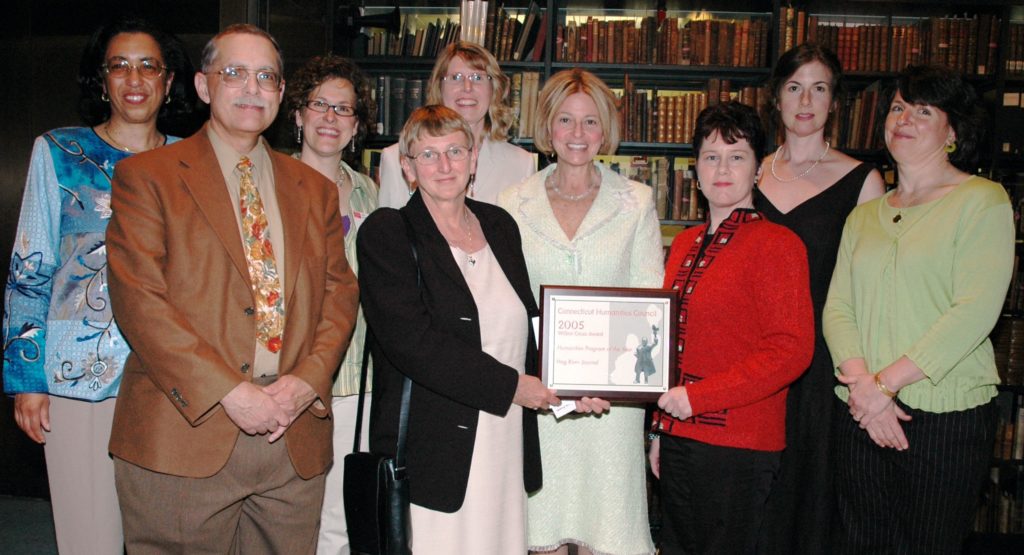
Members of the editorial team receiving the Connecticut Humanities Council’s Wilbur Cross Award from CTH board president Carol Clapp, held at the Beinecke Library, Yale University, 2005. (l to r) Joan Jacobs Williams, Mark Jones, Cindy Cormier, Nancy Albert, Elizabeth Normen, Carol Clapp, Clarissa Ceglio, Janice Mathews, Jennifer LaRue. Not pictured: John Alves.
Our editorial team, including staff members Diane Foley and Mary Donohue, editor Jennifer LaRue, and art director John Alves, was the secret to our success (see the Honor Roll, page xx). So, too, was our wide network of museum and historical society partners that we tapped for story ideas and writers. Early on we decided to plan issues around a theme—sometimes based on an anniversary of an important event in history, a topic being explored in a museum exhibition, or simply a topic of interest to us. We adopted themes that were big tents under which we could gather a variety of stories with broad appeal and that covered the state geographically, included people, places, events, and objects, and offered ethnic, gender, and racial diversity. This approach allowed us to dig deep and explore less-conventional aspects of Connecticut history such as food, childhood, medicine, and religion.
Our approach led to more collaboration and occasional guest editors, including CCSU history professors Matt Warshauer (Spring 2011 and Winter 2012-2013), who chaired the 150th anniversary of the Civil War in Connecticut commission, and Leah Glaser, whose specialty in the history of the American West led to an issue on that theme (Winter 2016-2017). Stonington Historical Society, New London County Historical Society, and Connecticut River Museum worked with us on an issue commemorating the War of 1812 (Summer 2012). Mystic Seaport Museum’s Bill Peterson and editorial team member Dave Corrigan (curator of the Museum of Connecticut History and formerly of Mystic Seaport) chaired our first issue about maritime history (Spring 2009).
One of our most important contributors and collaborators has been State Historian Walt Woodward, who retired from his post last June. He wrote his first story for us in Spring 2005 shortly after he was appointed to the position and began his quarterly column in 2011 (read them all at ctexplored.org/blog/). We often relied on Woodward to explain the tricky parts of Connecticut history, such as taking on our state monikers (“Are We the Constitution State?,” Spring 2005, and “Nutmeg Adds Spice, But is it Nice?,” Winter 2007), and his expanded column explaining just what the War of 1812 was all about (Summer 2012). In 2015, we joined forces to launch the co-produced Grating the Nutmeg podcast.
Editor Jennifer LaRue was a member of the early group of organizers and edited the prototype. Professional obligations took her away until the Summer 2005 issue, when she returned and stayed for every issue since. LaRue’s influence on the magazine may be hard to see. A journalist and staunch advocate of the Chicago Manual of Style, LaRue is also a stickler for sourcing. For easier reading though, she shifted us away from using footnotes to having authors embed their sources. Still, she steadfastly challenges authors to document where an assertion comes from, rarely letting unsubstantiated conjecture slip through. This level of sourcing seems to be increasingly rare outside of academic circles, but in my experience it leads to a better story for our readers. We have rarely had to run corrections.
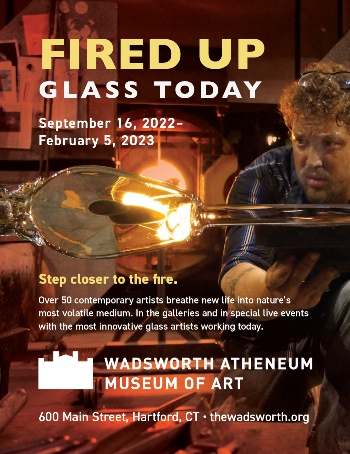 In a walk down memory lane, I re-read my publisher’s letter from our seventh issue, in which I describe how we operated, and it gave me a good chuckle. “When Susan Christensen of Fox 61 News offered to do a story about Hog River Journal last May, she suggested they come film the staff at our offices, putting the magazine together. But HRJ has no offices, and the ability to function without the expense of a physical location is, in part, what makes [the magazine]possible.” I further explain what a home office is (“outfitted with computer and Internet connection”!) and how “business is conducted between [editorial team]meetings by phone and e-mail.” How completely normal this way of working has become, and yet I remember feeling embarrassed, panicked, and flummoxed as to how to respond to Christensen’s suggestion!
In a walk down memory lane, I re-read my publisher’s letter from our seventh issue, in which I describe how we operated, and it gave me a good chuckle. “When Susan Christensen of Fox 61 News offered to do a story about Hog River Journal last May, she suggested they come film the staff at our offices, putting the magazine together. But HRJ has no offices, and the ability to function without the expense of a physical location is, in part, what makes [the magazine]possible.” I further explain what a home office is (“outfitted with computer and Internet connection”!) and how “business is conducted between [editorial team]meetings by phone and e-mail.” How completely normal this way of working has become, and yet I remember feeling embarrassed, panicked, and flummoxed as to how to respond to Christensen’s suggestion!
Book Publishing and Podcasting
Cindy reminded me that “In the beginning most people were positive [about the idea of a local history magazine], but there were a few people who felt print media was dead.” Though that prediction has not come true and the print magazine is thriving, it has driven us to try new things such as launching a website shortly after we began publishing, with expanded offerings over the years, and starting up Grating the Nutmeg with Walt Woodward in November 2015.
We moved into book publishing in 2014 with African American Connecticut Explored, in collaboration with Wesleyan University Press (WUP) and The Amistad Center for Art and Culture. The book started with the idea to repackage about 25 stories from the magazine into a book, but WUP encouraged us to build on that corpus. With a State Historic Preservation Office grant in hand, we commissioned new essays by three collaborating scholars: Dr. Stacey Close, Eastern Connecticut State University, Dr. Katherine Harris, Central Connecticut State University, and Dr. Frank Mitchell, The Amistad Center for Art & Culture. In all, the book comprises 50 essays by 30 scholars and provides one of the first public history volumes that explores what we called “the long arc of the African American experience in Connecticut.”
Our Key to Success: You!
Consistent with the marketing adage that people value what they pay for, Connecticut Explored has from Day 1 been a subscriber-supported publication. The key to our success has been our loyal subscribers and donor group Friends of Connecticut Explored.
So, too, have our organizational partners. We formalized the idea of the collective and launched with five: The Amistad Center for Art & Culture, Connecticut Landmarks, Hill-Stead Museum, Trinity College, and the Wadsworth Atheneum Museum of Art. We award virtual gold stars to Connecticut Landmarks and The Amistad Center for Art & Culture, who have been partners for all 20 years! Today we have more than 30 partners, which is remarkable, considering how challenging the last two years have been for museums and historical societies. That’s a testament to how much our partners value being part of Connecticut Explored (the feeling is mutual!) and how much they value your readership.
Opportunities and Challenges Ahead
Much has changed, and much has stayed the same over 20 years. (We still have no offices, and we still operate largely by email!) New, though, is our burgeoning education department, begun with the publication of Where I Live: Connecticut in 2017 for grades 3 and 4 and Venture Smith’s Colonial Connecticut (2019) for grades 5 to 8. Those publications have earned us awards and attracted grant funding, so now we have a small but well-established education department. We are excited to be launching a Grade 2 curriculum project with support from the State Historic Preservation Office and the BFA-Rena Koopman Fund at Hartford Foundation for Public Giving.
Our biggest development, of course, is welcoming Dr. Kathy Hermes as our new publisher. Please join me in welcoming her. Your support will continue to be a pillar of CTExplored’s success, especially as the world changes and changes again. We’ve been hit this year with two steep printing cost increases as supply chain issues cause paper to suddenly become dear. Let’s hope that’s temporary, but it’s hitting at a time when we are working hard to transition to a paid publisher for the first time in our history. Please be generous with your contribution this year to our Fund for Excellence in Publishing. Reaching our ambitious $100,000 goal will go a long way to carrying us through this transition and into the next 20 years of Connecticut Explored.
Meanwhile, we hope you enjoy our 20 for 20: Innovation in Connecticut History programs, stories, and podcasts, spread out over the next three issues. Find out more in our special section starting on page xx. And thank you to everyone one who has made Hog River Journal and Connecticut Explored such a valuable and rewarding experience. We couldn’t have done it without you.
Elizabeth J. Normen is Connecticut Explored’s Founding Publisher and President Emeritus. A frequent contributor to the magazine, she last wrote “George Washington in Connecticut,” Summer 2022.
GO TO NEXT STORY
GO BACK TO FALL 2022 CONTENTS

